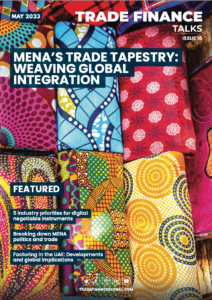At the 2023 ITFA Trade and Investment Forum in London, Trade Finance Global spoke with Alexander Malaket, president, OPUS Advisory Services, to learn more about trade finance as an asset class, the promise of a standardised rating system, and the role of ESG as a catalyst for investment
Trade finance as an asset class
Trade finance as an asset class refers to the packaging of trade finance transactions into investable securities or funds and then securitising these trade finance assets, which can be bought and sold on financial markets.
The goal of structuring trade finance as an asset class is to attract investment capital from a wider pool of investors to provide liquidity for trade finance transactions.
Small businesses often struggle to access trade finance, as traditional lenders such as banks may not have the balance sheet capacity or risk appetite to meet their financing needs, which has led to a significant trade finance gap, estimated at $1.7 trillion.
By structuring trade finance as an asset class, it may be possible to attract new sources of capital from investors looking for uncorrelated assets that can help balance their portfolios.
Malaket said, “There’s an old saying that trade finance has never met a crisis it doesn’t love. Where certain assets are underperforming in specific cyclical dynamics of the economy, trade finance often tends to counterbalance that behaviour.”
This makes it an attractive complement to other investments that may be more vulnerable to market fluctuations, as it can provide a hedge against economic volatility.
Although there have been frauds in the market, structured trade finance is generally considered less risky than other types of investments.
Additionally, in a high-interest rate environment, the yields on trade finance may be more appealing to investors, incentivising more capital and injecting liquidity into the market, which can help small businesses access the financing they need to grow and expand.
This can support international development in emerging markets, which can be a significant driver of economic growth.
The promise of a standardised rating system
A significant barrier to this increased investment is that investing in trade finance today requires a sound understanding of the complex contractual and operational risk issues.
There is a need for standardisation in the industry to make the investment process more comparable to other investment alternatives and less resource-intensive for asset managers. This would enable them to assess the investment opportunities more efficiently and make informed decisions without spending years developing domain-specific expertise.
This is one area where credit rating agencies can play a role, providing a level of comfort and trust for the investment community about the nature of these transactions and making it easier to attract investment capital.
Unfortunately, developing these ratings can be difficult and expensive.
Malaket said, “It’s one of those chicken and egg discussions: it’s difficult and expensive to develop the credit ratings, but it’s also challenging to attract the investment capital needed to pay for it without first having the credit ratings.”
These challenges can be mitigated by addressing some of the fundamental issues in the industry, such as standardisation, language, and definitions.
It will also be necessary to build a bridge between the trade finance practitioners and the asset managers’ community to better understand each other’s functions and needs to scale this whole proposition
Technology can also be an enabler in making the process of investing in trade finance easier, less complex, and more cost-effective.
The role of ESG as a catalyst for investment
Environment, social, governance (ESG) and sustainability can act as a catalyst to increase capital flows into trade finance as an asset class; however, there are some challenges that need to be addressed first.
These include establishing clear definitions and standards for ESG and sustainability, identifying transactions and businesses that are ESG and sustainability aligned, and ensuring that there is credible data and support for these claims to avoid greenwashing.
Once these challenges are addressed, it will become easier to credibly link ESG to trade finance and to attract more capital and investment into sustainable activities using trade finance as a mechanism for facilitating sustainable global supply chains.
There are several reasons why ESG and sustainability could be a catalyst to open up trade finance as an asset class.











































